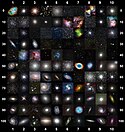NGC 4826 - HST
Here's an old favorite galaxy that I'm glad to have had the chance to process some new observations for. This is also known as the Black Eye galaxy, and is among the most striking galaxies that Hubble has looked at. Previously a Hubble Heritage image release, new imagery is around 2.5 times the resolution of the old WF/PC2 imagery. That means more refined details are visible, especially If you are able to zoom all the way in. In fact, the texture of the individual stars forming even the smooth, redder, non star-forming parts the galaxy are now revealed. If you do zoom in, don't mistake that grainy, noisy texture as actual noise. Those are stars!
I went ahead and did use some old WFPC2 data just to show glowing hydrogen gas. This usually works well without lowering the image quality, despite the disparity in resolution.
Data from the following proposals were used to create this image: PHANGS-HST: Linking Stars and Gas throughout the Scales of Star Formation The Smallest Nuclear Black Holes
Red: WFC3/UVIS F814W+WFPC2 F656N Green: WFC3/UVIS F555W Blue: WFC3/UVIS F438W+F336W+F275W
North is 142.85° clockwise from up.Relevante Bilder
Relevante Artikel
Messier 64Messier 64 ist eine Spiralgalaxie mit den Abmessungen 10′,0 × 5′,4 Bogenminuten und der scheinbaren Helligkeit von 8,5 mag im Sternbild Coma Berenices. Sie besitzt eine große ovale Dunkelwolke nördlich des Kerns mit einer Ausdehnung von etwa 8000 Lichtjahren und einer Größe von 9,2 × 4,6 Bogenminuten, die wahrscheinlich durch Verschmelzung mit einer kleinen, sehr staubreichen Galaxie vor rund einer Milliarde Jahren entstanden ist. Damit ließen sich die einseitige Konzentration der Dunkelwolken und die vielen in Kernnähe stehenden Regionen mit ungewöhnlich kräftiger Sternentstehung erklären. .. weiterlesen


